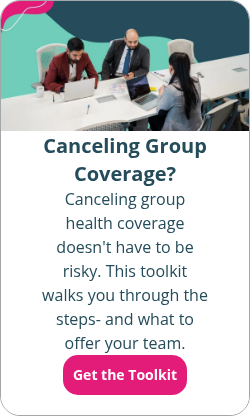Substantiation requirements for employee health benefits
By Holly Bengfort on February 7, 2024 at 7:44 AM
Employee health benefits are an essential component of any comprehensive compensation package. However, employers must ensure that the benefits they offer comply with federal and state laws. If you offer a flexible spending account (FSA) or health reimbursement arrangement (HRA) as a health benefit, failure to meet substantiation requirements can lead to legal complications and financial penalties.
In this article, we'll outline the substantiation requirements for these employee health benefits to help employers avoid any potential compliance issues.
Takeaways from this blog post:
- Substantiation requirements are necessary to ensure that employees use their funds from health benefit plans on eligible medical expenses.
- The process of substantiation differs depending on the type of health benefit, such as health flexible spending accounts (FSAs) and health reimbursement arrangements (HRAs).
- Employers are responsible for approving or denying reimbursement requests based on the documentation provided by employees and must handle declined requests and appeals according to their plan documents.
What are substantiation requirements?
Some employee health benefits allow employers to reimburse their employees for (or pre-fund accounts for their employees to use funds on) qualifying medical expenses.
The IRS established substantiation requirements for specific pre-tax health benefit plans that employers and employees need to follow to prove that employees used their funds from these plans for eligible medical expenses. Employees usually do this by providing a receipt or bill.
These substantiation rules apply to the following health benefits: health flexible spending accounts (FSAs) and health reimbursement arrangements (HRAs).
Each time an employee uses one of these benefits to pay for a premium, product, or service, they need to provide sufficient documentation that illustrates the following:
- The date of service (or purchase)
- A description of the service (or item)
- The name of the healthcare provider (or vendor)
- The dollar amount the provider charged
How does substantiation work for HRAs?
An HRA is a Section 105 reimbursement plan. Through an HRA, employers offer their employees a fixed monthly allowance. This allowance can cover the cost of individual health insurance premiums and other qualifying medical expenses depending on the type of HRA you offer. After an employee incurs a health expense, they can submit that expense to their employer for reimbursement.
There's a specific process for handling substantiation when it comes to HRAs. This section will break down that process.
Receiving and processing HRA claims
In the context of an HRA, a “claim” is a request for reimbursement. An HRA claim begins when an employee submits proof of a qualified expense to their employer. They can also submit their expense through an HRA benefits administration software provider, like PeopleKeep.
Proof of purchase could include the following:
- A receipt
- An invoice
- An explanation of benefits (EOB) statement
For the IRS to consider the proof valid, it must include details about the type of service or product, the date of service or sale, and the product or service cost.
Once the employee submits proof of their expense, you must approve or deny it. To approve the request, the expense must be HRA-eligible and have sufficient documentation to support it.
Paying health reimbursements
If you approve the reimbursement request, it moves on to the next step in the process—paying the reimbursement.
With an HRA, you can reimburse your employees in any of the following ways:
- Payroll
- Direct deposit
- Check
- Cash
With an HRA, you're responsible for paying the claim within the timeframe established in your plan documents. Only employees with minimum essential coverage (MEC) can receive HRA reimbursements that are free of income and payroll tax. If they forgo MEC, employers should list their reimbursements as taxable income at the end of the tax year.
Since your employees handle their own insurance status, you only need to reimburse them for their eligible expenses.
Handling declined reimbursement requests and appeals
If you determine the expense is ineligible under an HRA, you must notify the employee within 30 days. In some cases, such as if your employee didn't include proper proof of purchase, you might request additional information from the employee to help substantiate the request. In this case, you must give the employee 45 days to provide more information.
Suppose an employee can't provide additional documentation to support the request. In that case, you must follow the appeals process detailed in your plan documents, Department of Labor guidelines, and rules under the Employee Retirement Income Security Act (ERISA). It's important to note the person appointed to hear the appeal can't be the same person who declined the original request for reimbursement.
Recording reimbursements and storing documentation
The IRS obligates employers to keep records about all HRA reimbursements processed and issued throughout the tax year.
These records should include:
- Information on requests received
- Associated documentation
- Whether or not the organization approved or declined reimbursement
The statute of limitations for HRA claims under IRS law is seven years, so it's best practice to hang on to HRA claim documentation for at least that long.
How does substantiation work for FSAs?
A health FSA, also called a healthcare FSA or medical FSA, is a Section 125 cafeteria plan. An FSA allows employees to use pre-tax dollars for eligible medical expenses.
The IRS issued a warning1 to employers regarding the potential loss of tax-free status for benefits provided under their Section 125 cafeteria plan if employees self-certify or use shortcut methods to substantiate reimbursable expenses.
According to the IRS, cafeteria plan rules require independent third-party verification of claims. Otherwise, employers must include all payments made under a plan that allows self-substantiation in every employee's taxable wage income and subject to tax withholding.
As such, you or a third party must substantiate all FSA reimbursements. Similar rules also apply to dependent care expenses under dependent care FSAs, where employers can’t reimburse employees for expenses until the service provider actually provides the service.
How does substantiation work for health stipends?
With a health stipend, employees receive a fixed, taxable allowance that they can put toward individual health plan premiums and other out-of-pocket medical costs.
The IRS does not require substantiation for health stipends. That's because they aren't a formal health benefit and don't use tax-free dollars to reimburse employees. But there are still some critical requirements for you to know.
You can’t require proof of purchase if an employee uses a taxable stipend toward any eligible expenses under IRS Publication 502. If you did, it would subject your health stipend to more requirements under HIPAA, ERISA, the Affordable Care Act (ACA), and others.
Yet, there are exceptions to this rule. Some health stipend reimbursement requests can require substantiation. This can include evidence of direct primary care network membership fees and health-sharing membership fees.
When setting up a health stipend benefit, you'll need to know when an expense has a substantiation requirement and when one doesn't. Employee stipend administration software can help you keep track of any submitted receipts and your reimbursement amounts.
Conclusion
By staying diligent in their substantiation efforts, employers can provide employees with the benefits they deserve while remaining compliant with applicable laws and regulations.
While it's possible to self-administer an HRA, it's not easy. Employers have to deal with the challenge of substantiation, drafting plan documents, staying on top of employee communication, processing reimbursement requests, storing documentation, and more.
That's what makes having benefits administration software and an award-winning customer support team on your side a necessity. At PeopleKeep, we help you maintain compliance with federal law and complex IRS rules for HRAs. In return, you get a simple, cost-controlled benefit that you and your employees can afford.
This blog article was originally published on April 18, 2018. It was last updated on February 7, 2024.
Check out more resources
See these related articles

Types of employee reimbursements
Explore the different types of employee reimbursements, like travel, healthcare, and more. Learn how reimbursements benefit both employees and employers.

Can I reimburse employees for health insurance?
Learn about the two most common ways to compliantly reimburse employees for their healthcare: taxable stipends and health reimbursement arrangements (HRA).

Health insurance reimbursements: What are the options?
Explore your options for health insurance reimbursement. Understand what insurance reimbursement means and how HRAs can support employees.



